Recommended Titles for Reading Aloud
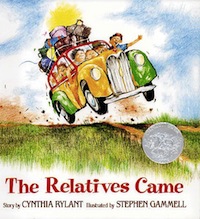
It's fun. It builds community and a sense of belonging. It strengthens vocabulary, language, grammar and writing. It makes us aware of other places and other lives. It creates life-long readers. There is a great deal of research that shows it to be the most effective part of any reading program.
We're talking about reading aloud of course. And, with effects like those above, you'd think that teacher's reading aloud to students would be front and center in every classroom, at least from kindergarten through 8th grade. But it isn't. Too many teachers feel "the basics" have crowded reading aloud out of their classrooms. Far too many administrators these days are discouraging such "frills." It's hard to believe, but there are actually superintendents and supervisors out there who say either directly or in effect, "If it isn't on the test, don't teach it." And, as far as we know, reading aloud is not on any of those tests. However, its results are in those test results.
Perhaps the best way to refute the narrow view is to point out that the read-aloud program can and should be pointing the way to almost any area of study. Name a topic and there's a good literary work that can take you and your students there full of motivation and ready to delve into the research and activities. Also, think about your own school days. We'll put money on the fact that, if you ever had a teacher who read to you consistently, you have never forgotten it. His or her well-thought out, challenging and carefully planned lessons are probably long since forgotten, but the story read aloud and the feelings and knowledge it created in you are still there at the edge of memory.
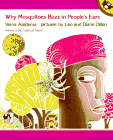
Now, having convinced all but the most recalcitrant of you that reading aloud is necessary, we've still got a ways to go because not just any book will do for our read aloud programs. That program must be as carefully thought out as any other part of the curriculum. The aim is to find the perfect book to read aloud at any given moment. A whole year's choices will very much depend on your curriculum; for us to outline it here would be presumptuous and too lengthy. We can, however, suggest some start up read aloud choices for each grade level and maybe insert a caution or two about your future choices.
So, it's September again and you've got a bunch of eager, slightly frightened, kids in front of you. They're not sure what you expect of them and so they're carefully watching every move you make, every expression on your face. You're not too sure about them either. Every class is different. You don't know what they expect of you. So you're carefully watching every move they make, every expression on their faces. You want to show them that reading is an essential part of learning in your classroom. What do you do? You pick up a book and begin to read aloud.
Starting off with the right choice for PreK, try The Relatives Came by Cynthia Rylant with illustrations by Stephen Gammell (Simon & Schuster, 1985 ISBN 0027772209. Order Info). It's just chuck full of humor and subtleties. Add to that the fact that it deals with extended families and we've got tons of things to point out to each other and to take in various directions. Follow one character throughout the story. Read more about this book including some math activities.
If those are kindergartners you're facing, our choice will be Verna Aardema's Why Mosquitoes Buzz in People's Ears illustrated by Leo and Diane Dillon (Dial, 1975 ISBN 0803760892. Order Info). The illustrations are striking and vivid. The plot is cumulative so that children who are not used to books and reading will get a recap of the action on each page. There's a lot to see on those pages because the illustrations show two plots simultaneously: what really happened and what was rumored to have happened. There's the red bird that appears for no particular reason on every page and that antelope-like creature that often mugs at the viewer. The plot is dramatic. It starts out funny with a mosquito saying something silly and an iguana going around with sticks in its ears. There is tragedy: a baby animal is killed and a mother grieves.
We can go from here to other cumulative stories, to other folktales from Africa, to other books illustrated by the Dillons, or to a theme on animals and we did it all with a picture book.
Don't be too quick to introduce longer books into the kindergarten or first grade curriculum. While some kids may be ready to hold a plot, largely unaided by illustrations, overnight for the next episode, many others are not. Stick with the picture books for a very long time.
Our first choice for first graders is Michelle Edwards' Chicken Man (Lothrop, 1991 ISBN 0688097081. Order Info). It introduces another community -- the kibbutz and the jobs that make the community work. We first meet Rody in the chickenhouse where he delights in his rapport with the chickens and is so cheerful about his work that others begin to demand that job. Rody is transferred from job to job but he makes the best of each and each seems enviable although both he and the chickens wish he were back with them. We know he'll get back there and he does, eventually.
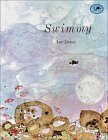
Of course, there's a point here and it's part of the reason for this choice, but the book is fun not didactic. We can go from it to the study of our own classroom community and the various small jobs that must be done to make it work or we can go for a larger community to study and get into the economics of goods and services. We can do a theme on the farm or we can specialize and stick with those chickens.
From here on up, we're still going to start with a picture book for the first book on the first day of school, but we'll use it to lead to a longer literary work.
For second grade, our picture book choice is another that accents community. Leo Lionni's Swimmy (Knopf, 1992 ISBN 0394826205. Order Info) has been around a long time, but it remains as delightful as ever. The tiny red fish are menaced by a large one until Swimmy figures out a way for them to work together, making the whole greater than the sum of its parts.
You can go from Swimmy to looking at ways communities protect each other. You can look at the fantastic collages in the book, created by printing with unusual objects and create your own water pictures. You can go from here to a study of ocean life.
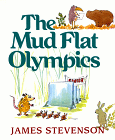
If you follow that book by reading aloud James Stevenson's short chapter book The Mud Flat Olympics (Greenwillow, 1994 ISBN 0688129234. Order Info), you'll be delving further into community activities. In this case, it's friendly games and the rules of community. Competition takes center stage but it doesn't destroy the community. The animal's Olympic games are hilarious: The All-Snail High Hurdle and The Smelliest Skunk Contest, for instance, but the animals love and respect each other and the community remains strong. That's good because there are several books about the Mud Flat community none of which are hard to read and we're hoping that the kids will want to read the rest of them on their own. More Information with classroom activities.
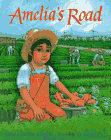
Our read aloud picture book for third grade is Amelia's Road by Linda Jacobs Altman with illustrations by Enrique O. Sanchez (Lee & Low, 1995 ISBN 188000027x. Order Info). Amelia's family travels to pick fruit and vegetables and she hates not having a place to belong. This time she is particularly anxious not to move on, because the teacher here has bothered to learn her name and has given her a star for a drawing she did of a house she'd like to live in. The story is respectful and honest about migrant life. After sharing Amelia's Road with the kids, we can go on to a study of migrant workers, to a unit on map study (Amelia hates maps because they lead to another place), or to a theme on home. That's where we're going with our choice for a follow-up novel for these third graders.
Seedfolks by Paul Fleischman (HarperCollins, 1997 ISBN 0060274719. Order Info) is about a community, about home and about hope. It starts with a little girl planting a seed in a vacant, trash-laden lot. This is a run-down urban neighborhood and, at first, her actions are viewed with suspicion -- she's probably hiding drugs, thinks one neighbor who sees her. Soon, however, others get involved and the garden that grows there transforms the neighborhood. What will transform yours?
Community gardens exist in many communities. Your class can figure out a way to start one at school or find a way to help an existing garden. If gardens aren't their thing, other community projects are within their reach.
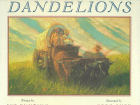
Fourth grade is going to start with a picture book about home as well. Eve Bunting's Dandelions with illustrations by Greg Shed (Harcourt, 1995 ISBN 015200050X. Order Info) brings us to the prairie. Since many fourth graders study the westward movement in the United States, this picture book about a little girl who plants a clump of dandelions on the roof of their sod house will surely lead us there. More Information with classroom activities, discussion points and web links.

We could go to what makes a place home or what beauty is. We could do a theme on wild flowers, or we could go to the novel which seems to fit so well with that picture book, Grasshopper Summer by Ann Turner (Troll, 1991 ISBN 0816722625. Order Info). Sam White's father makes the decision to leave grandparents and other family behind in Kentucky and head for the plains in Dakota Territory. For Sam, his father and younger brother, the sod house they build soon becomes home. His mother has a harder adjustment. When the land is cleared and the crops are planted, however, everybody's spirits are up -- until the grasshoppers come. The book is fairly short, reads aloud well and the description of grasshopper plague is suitably gross. It should open the way to independent reading of many novels and picture books set in this time and place. More Information with discussion ideas, teaching activities, related books and web links.
Fifth graders could start with a Chris Van Allsburg book. His are always intriguing and have many layers of meaning. We want to get them into looking beneath the surface of books so read aloud The Widow's Broom (Houghton, 1992 ISBN 0395640512. Order Info). The illustrations are wonderful and the story is reminiscent of "The Sorcerer's Apprentice" but it's the superstition and prejudice that we want to emphasize. The Spivey's determination to rid the neighborhood of the witch's broom and all its marvelous accomplishments is equaled by the widow's determination to keep her newfound friend and worker.
The novel to read next, The Witch of Blackbird Pond (Dell, 1978 ISBN 0395071143. Order Info), takes up the witchcraft theme and is a good introduction to the early settlers in America. A high spirited female character pitted against the superstition and fear of Puritan Connecticut is a good lead-in to that study or to a search for other strong characters who fight convention.
Sixth graders are idealists, for the most part, and so you might start with the picture book Rebel by Allan Baillie, illustrated by Di Wu (Ticknor & Fields ISBN 0395692504. Order Info). This story is about a community that stands together against a bully. Based on a true story, it tells of how a General marched his army into a village. They round up the villagers. "You are my people now!" he shouts and a single, small sandal is thrown at him from the crowd. Enraged, he orders his army to find the culprit -- the child wearing just one sandal -- but the villagers thwart him by putting all their sandals in a big pile and they all stand bare footed.
We can go from Rebel to Jerry Spinelli's Wringer (HarperCollins, 1997 ISBN 0060249137. Order Info). Here's a wonderful, frightening story about a kid who dares to rebel against a brutal custom that involves an entire town. They kill pigeons there during a yearly rite. Pigeons are captured and then released on the green and the men shoot them. Ten-year-old boys have a coming of age rite at that time -- they run out and wring the necks of any surviving pigeons. This year Palmer is ten. To refuse is to bring down condemnation and scorn upon his head. Every sixth grader has felt peer pressure to do something he or she knows is wrong. Here's a book that brings it to center stage.
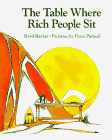
For seventh grade we can dig into value systems by reading aloud Byrd Baylor's wonderful picture book The Table Where Rich People Sit (Atheneum, 1994 ISBN 0684196530. Order Info) illustrated by Peter Parnall. Here a young narrator has called a family meeting to discuss money -- she thinks they don't have enough. Her parents, however, consider themselves quite rich and they proceed to describe and enumerate their riches. They value working out of doors, wildlife, sunsets, coyote howls and the beauty they see all around them. The humor keeps the book from being saccharine and it should get students thinking about the things they value.

We can go from that book to Lois Lowry's The Giver (Houghton, 1993 ISBN 0395645662. Order Info). In case you've been living in Antarctica and missed all the discussion about this book, we can tell you that it's about a seemingly ideal society. The society has eliminated all that they find inconvenient or unpleasant. They value conformity, good health and hard work. The price they've paid for their ideal society is something we learn about bit by bit. We should get into some good discussions as a result of this heart-stopping novel and, of course, a study of our society's values. More information with a longer summary and links to websites including teaching activities.
Eighth graders like to be read to too and we can use Ed Young's Lon Po Po: A Red-Riding Hood Story from China (Putnam ISBN 0399216197. Order Info). They'll be surprised at your choice of a fairy tale for eighth graders, but look where you can go with it. We could go to fairy tale variants around the world but it's even more fun to go to the wolves. Young's images of the wolf dominate the book in both obvious and subtle ways. Find them together and talk about images of wolves -- the atavistic fear and awe and respect that most of us hold for those fascinating creatures.
We'll go from it to Melvin Burgess's novel of obsession The Cry of the Wolf (Beech Tree, 1994 ISBN 0688136257. Order Info). What if there was one surviving wolf in England and what if a man's obsession was to kill that wolf? What if you knew where that wolf was and you inadvertently told the hunter? What if the tables were turned and the hunter became the hunted? You'd have a thriller and an audience of eighth graders sitting on the edge of their seats. We can go from there to other books about obsession, about wolves and about the pros and cons of hunting. More Information including web links.
Chaucer's Canterbury Tales is usually reading material for college students rather than ninth graders, but take a look at the edition illustrated by Trina Schart Hyman (Lothrop, 1988 ISBN 0688062016. Order Info). The selections are age appropriate and the artist vividly renders the characters. It's a good introduction to the time and to the idea of pilgrimage, which will be extended in our choice of novel for reading aloud to ninth graders.
The Ramsay Scallop by Frances Temple (Orchard, 1994 ISBN 0531068366. Order Info) is a wonderfully wise novel, steeped in careful research, and full of fascinating details about life in the middle ages. Elenor and Thomas's marriage has been arranged for them. Elenor is a curious, lively and joyful person who has been enjoying her life. Now, however, Thomas has returned from a crusade, discouraged and disillusioned about what he has done and seen during what should have been a holy war.
Father Gregory devises a pilgrimage for Elenor and Thomas to Spain. Their trek takes them around Europe, joining up with other pilgrims, getting to know many others and themselves. What they see and experience on their journey gives us insight into the way of life for many during the Middle Ages but Temple also offers ideas and dilemmas about such things as religion -- Catholic and Islam, honor, heroes, dedication, the nature of sin and the debts owed by human beings to each other.
You won't stop here, of course; you can't. Aim for quality and variety. If your first book is a fantasy, try for realism next time. If your first main character is female, the boys should find a hero in your next choice. Keep it varied. Keep the reading level one half step above that of the average reader in your class. Read aloud choices should open doors and help the kids reach for the best. Good luck.
Related Areas of Carol Hurst's Children's Literature Site
- Our Article on Parents Reading Aloud at Home:
http://www.carolhurst.com/profsubjects/reading/parentreading.html - Collection of Links on the Topic of Reading:
http://www.carolhurst.com/profsubjects/reading/reading.html
Related Areas on Other Web Sites
- Jim Trelease's site on reading aloud and his highly recommended book on reading aloud:
http://www.trelease-on-reading.com/
Advertisement:
Advertisement:
Advertisement:

